Here comes Treble: A modular base for Android
On the Android team, we view each dessert release as an opportunity to make Android better for our users and our ecosystem partners. One thing we've consistently heard from our device-maker partners is that updating existing devices to a new version of Android is incredibly time consuming and costly.
With Android O, we've been working very closely with device makers and silicon manufacturers to take steps toward solving this problem, and we're excited to give you a sneak peek at Project Treble, the biggest change to the low-level system architecture of Android to date.
Life of an Android Release
First, it's helpful to understand the "life of an Android release". There are several steps a new Android release goes through before getting into the hands of users:
- The Android team publishes the open-source code for the latest release to the world.
- Silicon manufacturers, the companies that make the chips that power Android devices, modify the new release for their specific hardware.
- Silicon manufacturers pass the modified new release to device makers — the companies that design and manufacture Android devices. Device makers modify the new release again as needed for their devices.
- Device makers work with carriers to test and certify the new release.
- Device makers and carriers make the new release available to users.
With Project Treble, we're re-architecting Android to make it easier, faster and less costly for manufacturers to update devices to a new version of Android.
The Vendor Interface
Android was unveiled in 2007 as a free, open-source mobile operating system. From the beginning, we intended Android to be scaled across a variety of manufacturers. We knew that consistency of API was important for developers, so we created a compatibility program for the Developer API specified by the Compatibility Definition Document (CDD) and its associated Compatibility Test Suite (CTS), now comprising over a million tests.
The result today is that app developers can write a single app that works across over a billion devices running on different hardware from different manufacturers.
Project Treble aims to do what CTS did for apps, for the Android OS framework. The core concept is to separate the vendor implementation — the device-specific, lower-level software written in large part by the silicon manufacturers — from the Android OS Framework.
This is achieved by the introduction of a new vendor interface between the Android OS framework and the vendor implementation. The new vendor interface is validated by a Vendor Test Suite (VTS), analogous to the CTS, to ensure forward compatibility of the vendor implementation.
Benefits of Project Treble
Today, with no formal vendor interface, a lot of code across Android needs to be updated when a device moves to a newer version of Android:
With a stable vendor interface providing access to the hardware-specific parts of Android, device makers can choose to deliver a new Android release to consumers by just updating the Android OS framework without any additional work required from the silicon manufacturers:
Project Treble will be coming to all new devices launched with Android O and beyond. In fact, the new Project Treble architecture is already running on the Developer Preview of O for Pixel phones.
In addition to the architectural changes, we're working with our silicon and device partners to take their code changes, such as features for a carrier network in a specific country, and move them into the common Android Open Source Project (AOSP) codebase. For example, Sony and Qualcomm contributed dozens of features and hundreds of bugfixes to Android O so they no longer need to rework these patches with each new release of Android.
We plan to publish the full documentation for Project Treble on source.android.com with the launch of O later this summer.
posted on 2019-06-25 15:47 huangguanyuan 阅读(257) 评论(0) 编辑 收藏 举报








【推荐】国内首个AI IDE,深度理解中文开发场景,立即下载体验Trae
【推荐】编程新体验,更懂你的AI,立即体验豆包MarsCode编程助手
【推荐】抖音旗下AI助手豆包,你的智能百科全书,全免费不限次数
【推荐】轻量又高性能的 SSH 工具 IShell:AI 加持,快人一步
· 从 HTTP 原因短语缺失研究 HTTP/2 和 HTTP/3 的设计差异
· AI与.NET技术实操系列:向量存储与相似性搜索在 .NET 中的实现
· 基于Microsoft.Extensions.AI核心库实现RAG应用
· Linux系列:如何用heaptrack跟踪.NET程序的非托管内存泄露
· 开发者必知的日志记录最佳实践
· TypeScript + Deepseek 打造卜卦网站:技术与玄学的结合
· Manus的开源复刻OpenManus初探
· AI 智能体引爆开源社区「GitHub 热点速览」
· 从HTTP原因短语缺失研究HTTP/2和HTTP/3的设计差异
· 三行代码完成国际化适配,妙~啊~